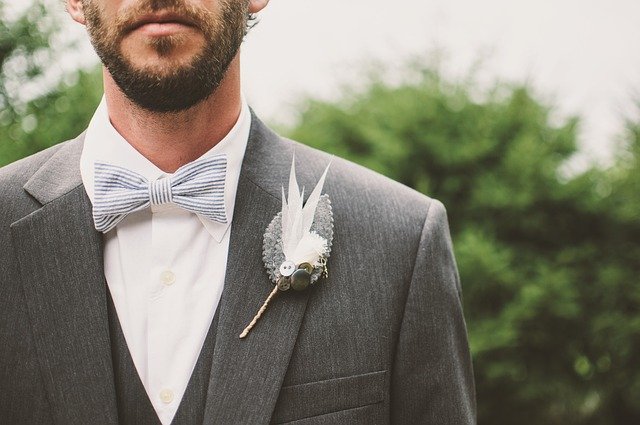Wedding Suits For Every Style And Occasion
Wedding suits come in many designs, colors, and fits, making them an important part of the big day. From classic black suits to light summer options, each style has a role in helping the groom look sharp and feel comfortable. This article explains the different types of wedding suits, common fabrics, and how they match with settings like outdoor, formal, or casual ceremonies. With simple details, it shows how wedding suits have become a timeless part of celebrations and why they remain a key piece of special occasion clothing.

Understanding Wedding Suits for Men
Wedding suits for men encompass a wide range of options designed to meet various ceremonial needs. Traditional wedding attire typically includes a jacket, trousers, waistcoat, shirt, and accessories like ties or bow ties. The choice of suit depends on several factors including the wedding’s formality, location, time of day, and season. Morning weddings often call for lighter colors and fabrics, while evening ceremonies may warrant darker, more formal attire. For beach or destination weddings, breathable fabrics like linen or lightweight wool blends provide comfort in warmer settings. Understanding these nuances helps grooms select suits that not only look appropriate but feel comfortable throughout their special day.
Essential Elements of Groom Wedding Suits
Groom wedding suits deserve special attention as they highlight the central figure of the celebration alongside the bride. The modern groom has numerous options beyond the traditional black tuxedo. Navy blue has become increasingly popular, offering a softer alternative to black while maintaining sophistication. Charcoal gray provides another versatile option that photographs well and complements various wedding color schemes. Accessories play a crucial role in distinguishing the groom’s attire from that of groomsmen – unique boutonnieres, special cufflinks, or a different waistcoat color can create subtle distinction. Many grooms also choose to personalize their suits with monogrammed details or meaningful accessories that connect to their relationship story.
Benefits of Tailored Wedding Suits
Tailored wedding suits offer unparalleled advantages over off-the-rack options. A professionally fitted suit enhances the wearer’s physique by addressing individual proportions and body shapes. The customization process typically begins 2-3 months before the wedding, allowing sufficient time for multiple fittings and adjustments. Beyond aesthetic benefits, tailored suits provide superior comfort through precise measurements and consideration of movement requirements. Tailors can recommend appropriate fabrics based on the wedding season and location – lightweight wools for summer events or heavier textured materials for winter celebrations. While initially more expensive than ready-to-wear alternatives, tailored suits often represent better long-term value through durability, reusability, and the confidence they instill in the wearer on such an important occasion.
Timeless Appeal of Classic Wedding Suits
Classic wedding suits have maintained their popularity through generations for good reason. The timeless black tuxedo with satin lapels represents the height of formal wedding attire, especially for black-tie events and evening ceremonies. Traditional suits in neutral colors like navy, charcoal, or black offer versatility and sophistication that transcend passing trends. The three-piece suit, featuring a matching waistcoat, provides a refined silhouette and practical benefits – the jacket can be removed later for comfort without sacrificing elegance. Classic styling elements like notch or peak lapels, single or double-breasted jackets, and subtle patterns like herringbone or pinstripes offer ways to incorporate tradition while expressing personal style. These enduring designs ensure wedding photos remain timeless rather than appearing dated as fashion evolves.
Embracing Modern Wedding Suits
Modern wedding suits reflect contemporary fashion sensibilities while honoring the occasion’s significance. Current trends include slimmer fits with tapered trousers and more structured jackets that create a sleek silhouette. Color experimentation has expanded beyond traditional neutrals to include rich burgundies, forest greens, and even patterns like subtle checks or windowpanes. Textured fabrics add visual interest and dimension to solid-colored suits. Many modern grooms are foregoing formal elements like waistcoats in favor of statement accessories or unique styling choices. Mix-and-match separates have gained popularity, allowing for personalized combinations like contrasting trousers and jackets. These contemporary approaches maintain formality while incorporating individuality and reflecting current fashion sensibilities.
Wedding Suit Options and Cost Considerations
Wedding suits vary significantly in price depending on factors including fabric quality, construction method, and customization level. Understanding the market helps grooms make informed decisions within their budget constraints.
| Suit Category | Description | Typical Price Range |
|---|---|---|
| Ready-to-Wear | Off-the-rack suits requiring minor alterations | $200-$800 |
| Made-to-Measure | Semi-custom suits using standard patterns adjusted to measurements | $800-$1,500 |
| Bespoke | Fully custom suits with hand-cut patterns and multiple fittings | $1,500-$5,000+ |
| Rental Options | Temporary suit rental for single-use occasions | $150-$300 |
| Designer Labels | Premium brands with distinctive styling and higher-quality materials | $1,000-$3,000 |
Prices, rates, or cost estimates mentioned in this article are based on the latest available information but may change over time. Independent research is advised before making financial decisions.
Selecting the Perfect Wedding Suit
Choosing the right wedding suit involves consideration of multiple factors beyond personal preference. The wedding’s formality level provides the primary guideline – black tie events require tuxedos, while semi-formal or casual weddings allow greater flexibility. The venue and season should influence fabric choices and suit weights. Color coordination with the overall wedding palette ensures visual harmony in photographs. Body type considerations help determine the most flattering cut and style. Testing comfort by moving, sitting, and even dancing in potential suits during fittings prevents discomfort during the lengthy celebration. Advance planning is essential, with experts recommending beginning the suit selection process at least three to four months before the wedding date to allow for alterations and accessory coordination. This thoughtful approach ensures the final selection not only looks remarkable but supports an enjoyable, confident wedding experience.




